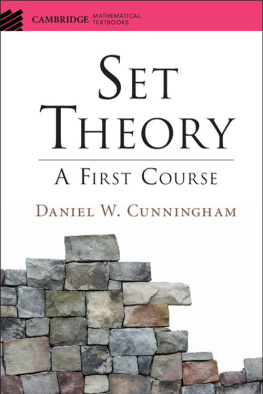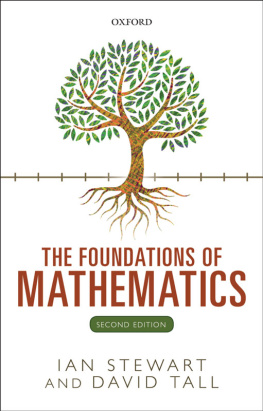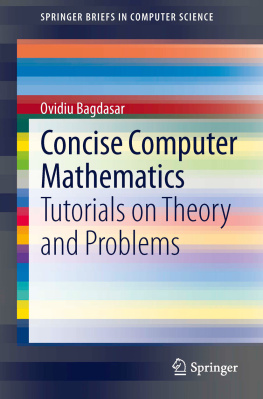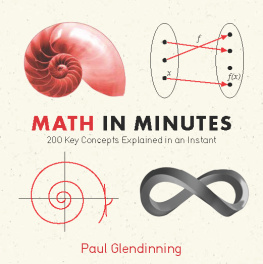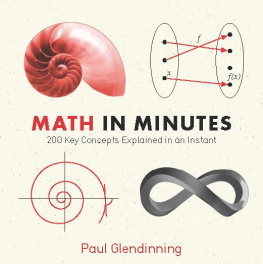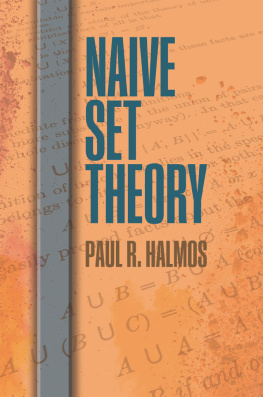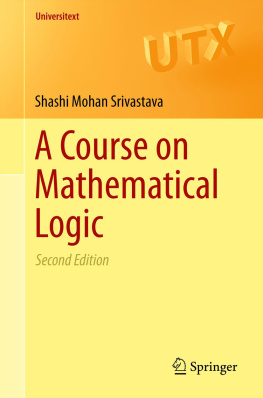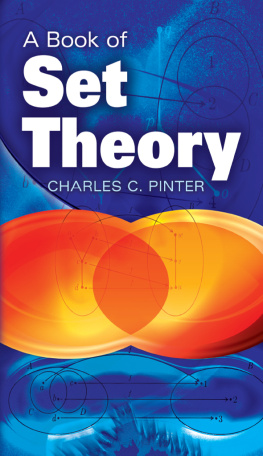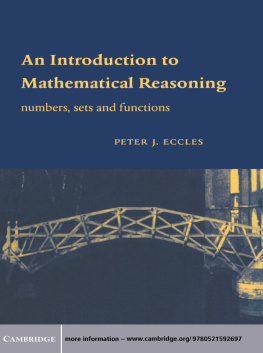Cambridge MathematicalTextbooks is a program of undergraduate and beginning graduate leveltextbooks for core courses, new courses, and interdisciplinary coursesin pure and applied mathematics. These texts provide motivation withplenty of exercises of varying difficulty, interesting examples, modernapplications, and unique approaches to the material.
Set Theory
A First Course
DANIEL W. CUNNINGHAM
SUNY Buffalo State, USA


OneLibertyPlaza,20thFloor,NewYork,NY10006,USA
CambridgeUniversityPressispartoftheUniversityofCambridge.
ItfurtherstheUniversitysmissionbydisseminatingknowledgeinthepursuitofeducation,learning,andresearchatthehighestinternationallevelsofexcellence.
www.cambridge.org
Informationonthistitle:www.cambridge.org/9781107120327
DanielW.Cunningham2016
Thispublicationisincopyright.Subjecttostatutoryexception
andtotheprovisionsofrelevantcollectivelicensingagreements,
noreproductionofanypartmaytakeplacewithoutthewritten
permissionofCambridgeUniversityPress.
Firstpublished2016
PrintedintheUnitedStatesofAmericabySheridanBooks,Inc.
AcatalogrecordforthispublicationisavailablefromtheBritishLibrary.
LibraryofCongressCataloginginPublicationData
Names:Cunningham,DanielW.
Title:Settheory:afirstcourse/DanielW.Cunningham,BuffaloState,NY,USA.Description:NewYorkNY:CambridgeUniversityPress,2016.|Series:Cambridgemathematicaltextbooks|Includesbibliographicalreferencesandindex.
Identifiers:LCCN2015047021|ISBN9781107120327(hardback:alk.paper)
Subjects:LCSH:SettheoryTextbooks.
Classification:LCCQA248.C862016|DDC511.3/22dc23
LCrecordavailableathttp://lccn.loc.gov/2015047021
ISBN 978-1-107-12032-7Hardback
CambridgeUniversityPresshasnoresponsibilityforthepersistenceoraccuracyofURLsforexternalorthird-partyInternetWebsitesreferredtointhispublicationanddoesnotguaranteethatanycontentonsuchWebsitesis,orwillremain,accurateorappropriate.
Contents
1.1
1.2
1.3
1.4
1.5
2.1
2.1.1
2.1.2
2.1.3
2.1.4
2.1.5
2.1.6
2.2
2.2.1
2.2.2
3.1
3.2
3.2.1
3.2.2
3.2.3
3.3
3.3.1
3.3.2
3.3.3
3.3.4
3.4
3.5
4.1
4.2
4.2.1
4.3
4.4
5.1
5.2
5.3
5.4
6.1
6.2
6.2.1
6.2.2
7.1
7.1.1
7.2
7.2.1
7.3
8.1
8.2
8.3
8.4
9.1
9.2
9.3
Preface
Set theory is a rich and beautiful subject whose fundamentalconcepts permeate virtually every branch of mathematics. Yet, mostmathematics students receive only a cursory overview of the theory of sets intheir lower division courses. Set theory is a subject that is sufficientlyimportant and interesting to merit its own undergraduate course.The book is intended to offer the reader, or department, just such acourse.
This introductory textbook delivers a one-semester course in undergraduateset theory at the upper-division level. Sets, of course, are the central objectsthat shall be investigated. Since essentially every significant concept inmodern mathematics can be defined in terms of sets, students who possess afairly deep understanding of set theory will find a first course in abstractalgebra or real analysis much less formidable and, perhaps, much moreaccessible. My first undergraduate course in set theory, for example, gave mea definite advantage over other students in my ensuing mathematicscourses.
In this book, the fundamental facts about abstract setsrelations,functions, natural numbers, order, cardinality, transfinite recursion, theaxiom of choice, ordinal numbers, and cardinal numbersare covered anddeveloped within the framework of axiomatic set theory. Mathematicianshave shown that virtually all mathematical concepts and results can beformalized within set theory. This has been recognized as one of the greatestachievements of modern mathematics, and, consequently, one can now saythat set theory is a unifying theory for mathematics.
The textbook is suitable for a broad range of readers, from undergraduateto graduate students, who desire a better understanding of the fundamentaltopics in set theory that may have been, or will be, overlooked in their othermathematics courses. I have made an effort to write clear and completeproofs throughout the text.
Many modern books in undergraduate set theory are written for a readerwho is well versed in mathematical argument and proof. My primarygoal was to produce a book that would be accessible to a relativelyunsophisticated reader. Nevertheless, I have composed completely rigorousproofs. In addition, these proofs favor detail over brevity. Another goal wasto write a book that is focused on those topics that a student is likely to seein advanced courses (including graduate courses). Thus, the bookis comparatively concise and can be covered in one semester. Mostother undergraduate set theory texts cannot possibly be covered in asemester.
On the Origins of Set Theory
In the nineteenth century, mathematicians were investigating problems thatconcerned functions in real analysis. Some of these problems involved therepresentation of a function by a trigonometric series and the convergence ofsuch series. The young Georg Cantor then proved a uniqueness theoremfor trigonometric series. Cantor, in his proof, introduced a processfor constructing collections of real numbers that involved an infiniteiteration of the limit operation. Cantors novel proof led him to a deeperinvestigation of sets of real numbers and then to the concept of transfinitenumbers.

